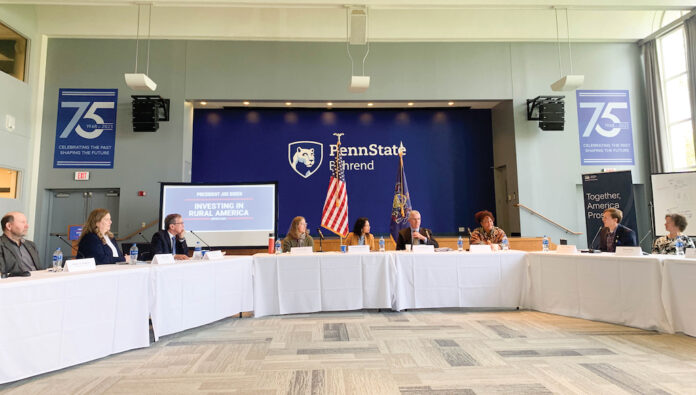
ERIE, Pa. — Stephanie Ciner’s Wild Field Urban Farm wouldn’t be where it is today without funding from the U.S. Department of Agriculture.
Ciner started her urban farm in 2017 in her backyard in downtown Erie. She expanded into two adjacent sidelots in 2020, but a lack of nutrients in the soil from previous urban development was affecting the growth of her plants.
“On my farm, my soil has been through a lot of degradation from its use and there are many places I can’t grow crops in the ground,” said Ciner.
The USDA’s Urban Innovative Infrastructure Grant allowed her to implement raised beds and explore new avenues to growing food in urban spaces, Ciner said during a roundtable discussion held April 23 at Penn State Behrend.
USDA Deputy Secretary Xochitl Torres Small and Pennsylvania Department of Agriculture Secretary Russell Redding, along with producers and agricultural educators, discussed the benefits USDA grants have had on connecting urban and rural food systems, farm-to-school programs and climate-smart agriculture.
Producers also discussed new revenue stream opportunities, labor shortages and the lack of funding for urban farms.
Farm-to-school programs flourishing
Doreen Petri is the project director of the Farm to School program at Erie City School District and was among the panelists who spoke on the successes of the USDA’s farm-to-school program. Petri manages 14 school gardens, which she has received three USDA grants for since 2018.
Students involved in Erie’s farm-to-school program have gone on field trips to local farms, planted vegetables, set up composting systems and more.
“It’s very important to us to teach our children where their food comes from, how to grow it, how to use it and understand all the benefits from it,” said Petri.
Petri adds the USDA’s grants have helped them connect urban and rural producers, specifically referring to Ciner’s Wild Field Urban Farm that has evolved into an educational field trip site where students get to learn about growing food in an urban setting.
Before Ciner could host field trips, though, she had to figure out how to grow crops in an urban setting with degraded soil. The funding she received through the Urban Innovative Infrastructure Grant allowed her to install raised beds and explore methods like cover crops for growing food.
“The USDA has been very helpful to me in my journey as a farmer,” said Ciner. “There are a few spots where I wanted to try crops that were not working well. That funding allowed me to try something new.”
USDA conservation programs
Panelists and officials discussed the advantages of the USDA’s conservation programs, including the Environmental Quality Incentives Program and the Conservation Reserve Program.
Specifically, the EQIP program has helped Robert Waddell, farmer and owner of Apple Shamrock Farms, implement numerous conservation and climate-smart ag practices on his farm over the years.
Waddell, who runs a dairy and crop farm in Crawford County, Pennsylvania, built an ag waste storage system, buffers around his streams and access roads and planted cover crops on his farm through EQIP funding. The project was costly — almost half a million dollars — but EQIP helped pay for the cost and the advantages are immense, he said. The system recycles Waddell’s sand bedding, reducing overall truck loads and costs.
“We used 50 truckloads of sand a week before we started recycling,” said Waddell. “Now we capture about 80% of that sand (and) use 10 loads a week. So that cut down on the amount of trucking, and we can recycle the sand and get it out of the manure stream.”
The conservation programs have also added another revenue stream for Waddell. Currently, a methane digester is being built on Apple Shamrock Farms. The digester breaks down manure into biogas and simple organics which can generate electricity. It will allow Waddell to negate his electric bill and add another stream of income.
Torres Small also talked about how the USDA’s National Resources Conversation Service Center and the Conservation Reserve Program offer both funds and assistance to farmers looking to incorporate waste management services in their operations.
Waddell recommends farmers interested in implementing sustainability practices on their farms should start by contacting the NRCS where they will help set up a step-by-step plan.
Concerns
Kirsten Weeks, owner and operator of Grow and Glow Urban Collective farm, discussed the lack of funding available for urban farmers with small spaces. She started the collective to band together urban farms like Ciner’s farm to create a market providing local, healthy foods to Erie’s most vulnerable community members.
She started her urban farm in 2023. It’s a quarter of an acre funded by the community. Weeks is looking for land to expand, but says “I don’t see how the USDA can assist me because it’s such a small scale, I run a non-profit (and) don’t have any organizational backing.” She has never applied for a USDA grant or loans and doesn’t plan to.
Torres Small said even if she didn’t want to apply for funding, Weeks could seek help at Urban Service Centers.
In July 2023, for the first time, the USDA announced the opening of 17 Urban Service Centers nationwide and an investment of $40 million into these centers and “partnerships with community-based organizations.” The closest ones to Weeks, however, are in Philadelphia and Cleveland.
Additionally, concerns about labor shortages were brought up at the roundtable. According to the United States Census Bureau, Crawford County’s population — where Waddell’s farm is located — was 88,765 in 2010 and by 2022 it had dropped to 82,405. The population decline has resulted in rural farms fighting over limited labor.
Waddell believes the labor shortages go back to investing in more agriculture education.
“As the kids grow up in a rural community, a lot of them go to other states to find a job,” said Waddell. “They don’t understand the opportunities that agriculture can give.”
(Liz Partsch can be reached at epartsch@farmanddairy.com or 330-337-3419.)









